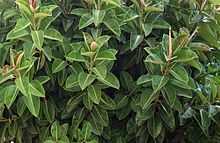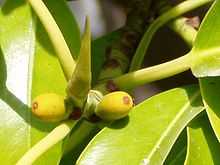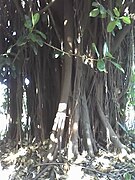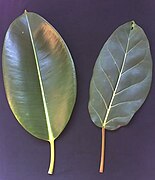Ficus elastica
| Ficus elastica | |
|---|---|
 | |
| Scientific classification | |
| Kingdom: | Plantae |
| (unranked): | Angiosperms |
| (unranked): | Eudicots |
| (unranked): | Rosids |
| Order: | Rosales |
| Family: | Moraceae |
| Tribe: | Ficeae |
| Genus: | Ficus |
| Subgenus: | Urostigma |
| Species: | F. elastica |
| Binomial name | |
| Ficus elastica Roxb. | |
Ficus elastica, also called the rubber fig, rubber bush, rubber tree, rubber plant, or Indian rubber bush is a species of plant in the fig genus, native to northeast India, Nepal, Bhutan, Burma, China (Yunnan), Malaysia, and Indonesia.[1]
Description
It is a large tree in the banyan group of figs, growing to 30–40 metres (98–131 ft) (rarely up to 60 metres or 200 feet) tall, with a stout trunk up to 2 metres (6.6 ft) in diameter. The trunk develops aerial and buttressing roots to anchor it in the soil and help support heavy branches. It has broad shiny oval leaves 10–35 centimetres (3.9–13.8 in) long and 5–15 centimetres (2.0–5.9 in) broad; leaf size is largest on young plants (occasionally to 45 centimetres or 18 inches long), much smaller on old trees (typically 10 centimetres or 3.9 inches long). The leaves develop inside a sheath at the apical meristem, which grows larger as the new leaf develops. When it is mature, it unfurls and the sheath drops off the plant. Inside the new leaf, another immature leaf is waiting to develop.
Pollination and fruiting
As with other members of the genus Ficus, the flowers require a particular species of fig wasp to pollinate it in a co-evolved relationship. Because of this relationship, the rubber plant does not produce highly colourful or fragrant flowers to attract other pollinators. The fruit is a small yellow-green oval fig 1 centimetre (0.39 in) long, barely edible; it will only contain viable seed where the relevant fig wasp species is present.
Cultivation and uses
In parts of India, people guide the roots of the tree over chasms to eventually form living bridges.[2]
Ornamental
Ficus elastica is grown around the world as an ornamental plant, outside in frost-free climates from the tropical to the Mediterranean and inside in colder climates as a houseplant. Although it is grown in Hawaii, the species of fig wasp required to allow it to spread naturally is not present there.
In cultivation, it prefers bright sunlight but not hot temperatures. It has a high tolerance for drought, but prefers humidity and thrives in wet, tropical conditions. Ornamental hybrids (such as Robusta) have been derived from Ficus elastica with broader, stiffer and more upright leaves than the wild form. Many such hybrids exist, often with variegated leaves.

Most cultivated plants are produced by asexual propagation. This can be done by planting cuttings or air layering. The latter method requires the propagator to cut a slit in the plant's stem. The wound, which oozes with the plant's latex, is packed with rooting hormone and wrapped tightly with moist sphagnum moss. The whole structure is wrapped in plastic and left for a few months. When it is unwrapped, new roots have developed from the plant's auxiliary buds. The stem is severed and the new plant is potted on its own.
Latex
Ficus elastica yields a milky white latex, a chemical compound separate from its sap and carried and stored in different cells. This latex was formerly used to make rubber,[1] but it should not be confused with the Pará rubber tree, the main commercial source of latex for rubber making. Just as with Hevea brasiliensis, the latex of Ficus elastica is an irritant to the eyes and skin and is toxic if taken internally.
Gallery
-

Illustration from Köhler's Medicinal Plants (1887)
-
Stem of Ficus elastica
-
Leaves and stem
-
Ficus elastica leaf on the left compared to Ficus lutea on the right
-

Ficus elastica near the roadside in Savusavu, Fiji, showing the effects of constant pruning on the growth form.
-

A huge Ficus elastica tree in Ghana showing the aerial roots.
References
- ↑ 1.0 1.1 Zhengyi Wu, Zhe-Kun Zhou & Michael G. Gilbert. "Ficus elastica". Flora of China. Missouri Botanical Garden, St. Louis, MO & Harvard University Herbaria, Cambridge, MA. Retrieved 29 August 2013.
- ↑ Living Root Bridges
| Wikimedia Commons has media related to Ficus elastica. |


